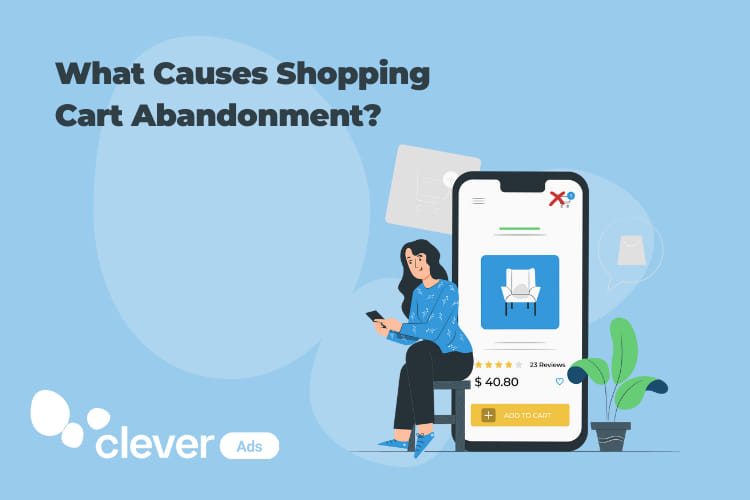Prevent your customers from leaving the shopping cart
What does it mean cart abandonment? It happens when a website user leaves a shopping cart without completing their purchase.
The good news about it is that that 63% of abandoned merchandise is potentially recoverable. The bad news is that the abandonment rate is increasing. Current estimates that 70% to 80% of all online shopping carts are abandoned, amounting to $4 trillion in lost sales.
We’ll tackle how retailers can reduce shopping cart abandonment or recover some of these abandoned sales in a bit. But first we want to review the key reasons shopping carts are abandoned.
Let’s get the tire kickers out of the way
People don’t always shop with the intent to buy. Sometimes, you want to see products and adding them to your cart is a way to bookmark a product and continue researching.
In a study of over 1,700 online shoppers, the Baymard Institute revealed that nearly 59% of people abandon their shopping carts. Why? Because they’re just browsing and aren’t ready to make a purchase. The study segmented these browsers out so they could focus on the real reasons that people abandon their carts.
The top issues that lead to shopping cart abandonment

There are ten reasons listed in the Baymard study, and we’re going to review the top four reasons the first one is shipping costs. Although one can argue that high shipping can also be remedied by offering users flat-fee shipping, some type of discount or requiring a minimum order amount to qualify for free shipping.
#1 Reason for Shopping Cart Abandonment = Shipping Costs
The first reason that people abandon shopping carts is because they encounter extra costs – specifically, shipping, tax and other fees. This may not be any easy fix for some retailers, but this people don’t want to pay for shipping.
In a recent survey of 1,400 shoppers…
- A staggering 91% of consumers indicated that free shipping would make them a repeat customer.
- 67% Indicated they would add more items to their cart to receive free shipping.
#2 People Don’t Appreciate Being Forced to Create an Account
The Baymard study revealed that 37% of people abandon their carts because they’re forced to create an account before completing their purchase. A study by Layer0, a mobile web eCommerce platform, revealed that conversion rates for shoppers who use guest check-in and those who were logged in were identical and that the logged in users spent an average of 10% more than guest users. Even so, there’s still a strong case to be made for giving users the guest checkout option. The Layer0 study revealed that mobile shoppers are 1.2x more likely to select guest checkout rather than logging in and that guest checkout tends to improve mobile conversion rates.
#3 Long Checkouts Are Conversion Killers
The Baymard study’s third top reason that users abandon their carts was due to a long or complicated checkout process. Nearly 30% of US online shoppers have abandoned an order due to this reason. Baymard did a large-scale usability study on the checkout process which revealed that checkout flow could be simplified to as little as 12-14 form elements (7-8 if only including form fields), but most US eCommerce sites contain over 23 elements (14 if only including form fields).
#4 Show Users Their Total Cost or You May Lose Them
23% of people interviewed by Baymard indicated that they abandoned their shopping cart merchandise because they couldn’t get their total order cost up-front.This is directly tied to the #1 reason for cart abandonment – extra costs, particularly shipping costs.
A Few Ways To Reduce Shopping Cart Abandonment
#1 Send checkout recovery emails
Checkout recovery emails (e.g., Hey, you forgot something!) are an effective way to recover sales from abandoned carts. According to Omnisend, 46% of people with open cart abandonment emails, 13% click on the email and 35% of people who click end up buying something Here are a few ways you can sweeten the pot for undecided shoppers:
- Offer a discount (e.g., 15% off all items in your cart)
- Keep the message short and sweet (e.g., Still shopping?)
- Communicate urgency (e.g., Get your items in 2 days if you order today!)
#2 Simplify your checkout process
Use a progress indicator if you, like most retailers, have a multi-stage checkout process and try to keep the checkout process to less than 5 steps (5 steps is the average length of the checkout process among the top 100 online retailers).
#3 Offer a discount
People love a bargain. Over 25 million Americans are using mobile coupon apps to find discounts each month and emails containing coupons offer a 48% increase in revenue per email (an important statistic to consider when crafting your checkout recovery emails).
- Try to boost your offers easier with our Google Ads creator tool!
#4 Don’t require users to register to complete a purchase
In the ideal (and nonexistent) retail world, all users would happily create an account before completing their purchase. However, we live in an imperfect world where people crave options. One option, as mentioned above, is to offer guest checkout. Another is to allow people to login via their Facebook, Google, or another social media account.
Conclusions
While we focused on the top four reasons people abandon their shopping carts, it’s important to look at the big picture when considering shopping cart abandonment. Familiarize yourself with all of the top issues listed in the Baymard study, and try to address each one of them.
When you discount the window shoppers and tire kickers, many true abandonment issues are connected to each other. When taken together, the various issues tell a larger story. Shipping prices and other added costs may not be a dealer breaker (for example), but when combined with other road blocks such as website errors, slow delivery times, and a poor or nonexistent return policy, lack of free shipping may be what causes a consumer to ditch their cart.
The good news is that potential is huge to recover some of those abandoned carts. By crafting recovery emails with great subject lines, offering incentives such as discounts or free items, and ensuring that the checkout process is simple, mobile-friendly and secure, you can recover some of those potentially lost sales and gain new, loyal customers in the process. And before You leave, I recomend You this article which will teach You how to generate sales leads. Btw, are you acquainted with the PMAX campaigns conducted by Google and Microsoft? They’re definitely worth checking out!
Ryan Gould
Vice President of Strategy and Marketing Services
From legacy Fortune 100 institutions to inventive start-ups, Ryan brings extensive experience with a wide range of B2B clients. He skillfully architects and manages the delivery of integrated marketing programs, and believes strongly in strategy, not just tactics, that effectively align sales and marketing teams within organizations.




